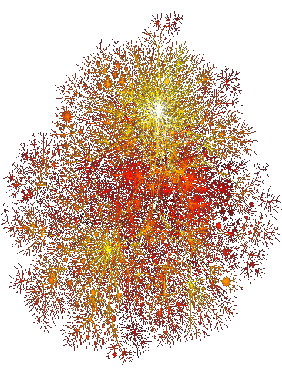CAIDA NGI Project Objective
UCSD/CAIDA is focusing on advancing the capacity to monitor, depict, and predict traffic behavior on current and advanced networks, through developing and deploying tools to better engineer and operate networks and to identify traffic anomalies in real time. CAIDA is concentrating efforts in the development of tools to automate the discovery and visualization of Internet topology and peering relationships, monitor and analyze Internet traffic behavior on high speed links, detect and control resource use (security), and provide for storage and analysis of data collected in aforementioned efforts. CAIDA's cooperative agreement with DARPA for funding these vital activities went into effect on July 16th, 1998.
Principal Investigator: kc claffy
Funding source: N66001-98-2-8922 Period of performance: September 15, 1997 - October 15, 2001.
Predictability and Security of High Performance Networks:
Expanding Control through Monitoring, Visualization and Analysis

|
Active measurement activitiesA major focus of CAIDA's NGI effort is the gathering and analysis of Internet traffic path data (connectivity, routing and performance), with the help of a tool called skitter. This tool intermittently sends ICMP packets to many destinations (thousands). The number of servers receiving measurement packets is so large that it is impossible for us to notify all of the administrators individually of the reason for the unusual ICMP traffic.Some have mistaken our measurements as hostile activity. PLEASE note that CAIDA has no hostile intentions whatsoever. Our intent is measurement only, at a low enough frequency to not be a significant network resource consumer at an end site (typically one 52-byte packet every half hour or less). CAIDA's measurement efforts are intended to help users, providers and researchers understand the complexities in the current and future Internet. skitter is intended to help us understand one part of the complexity: a large and varied worldwide topology. |
The image displayed here is a visualization generated by Hal Burch of CMU during a summer internship with Lucent Bell Laboratories, using skitter data. In this picture, lighter colors represent links closer to the source and darker colors are used for links further from the source (by hop count).
More Information about the CAIDA NGI Effort
Passive monitoring with CoralReef
Path and Round Trip Time Measurements using skitter
Security Management in Next Generation Networks (Coral Security Applications)
Additional Content
NGI Security Research
CAIDA is collaborating with the Pacific Institute for Computer Security at SDSC to enhance the OC12mon passive traffic monitor to facilitate ubiquitous network monitoring at aggregation points by developing filtering and data collection, security policy compliance/enforcement components.


